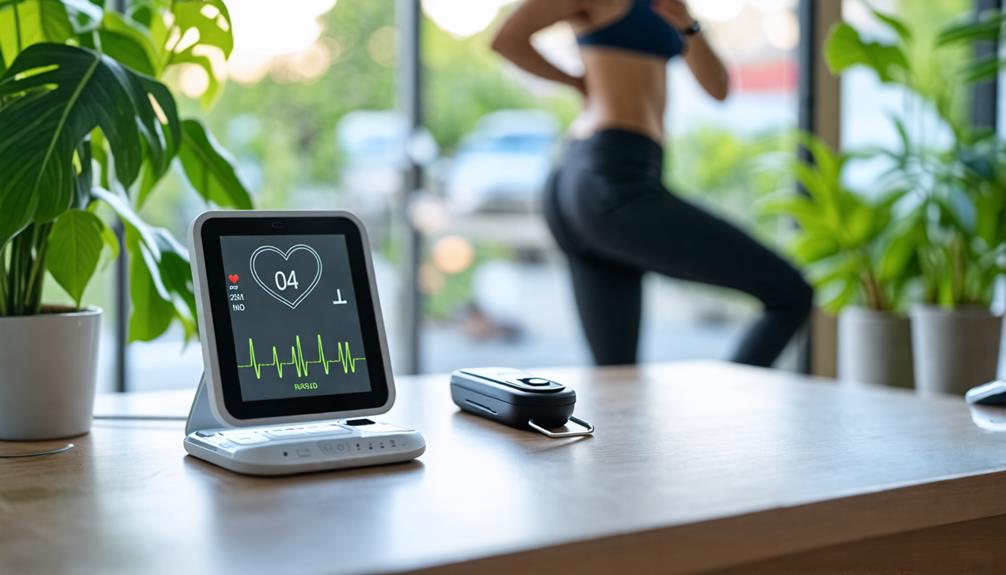Standing Desks Proven Better With 7 Scientific Reasons

Using a standing desk can greatly improve your overall health and productivity. By reducing prolonged sitting, you can combat the increased risk of heart disease, cancer, and diabetes associated with sedentary jobs, which have risen by 83% over the past 50 years. Standing desks help burn more calories, boost energy, and improve mental focus by enhancing blood circulation and oxygen delivery to the brain. Additionally, they alleviate chronic back and neck pain, improve posture, and enhance heart health by reducing cholesterol levels. If you continue, you'll find even more benefits and ways to incorporate standing desks into your daily routine.
Combating Sedentary Behavior

As you stare at your screen for hours on end, it's essential to combat sedentary behavior, especially considering that sedentary jobs have skyrocketed by 83% over the past 50 years. This trend has greatly contributed to health risks such as heart disease, cancer, and diabetes.
Standing desks can help reduce sitting time, which is vital since prolonged sitting is now recognized as a major health risk factor. In contrast, regular movement can benefit overall health considerably, even if it's just light activity.
For instance, simply standing for 180 minutes after meals can decrease blood sugar spikes by up to 43%, greatly mitigating the negative effects of prolonged sitting. By incorporating standing desks into your work routine, you can considerably lower your health risks and improve your overall wellbeing.
Consider an adjustable standing desk, which can help break up the long periods spent sitting. Additionally, it's suggested to break up sitting into 8-minute intervals to further enhance your activity levels throughout the day.
Weight Management and Energy Boost

By committing to standing for at least part of your workday, you can utilize the calorie-burning advantages of a standing desk to improve your weight management and energy levels.
One significant benefit is the additional calories burned while standing, which can amount to over 170 extra calories in an afternoon, leading to nearly 1,000 extra calories weekly.
This increased calorie expenditure not only supports weight management but also encourages an active lifestyle, reducing the risk of obesity and related chronic diseases.
In addition, using a standing desk can help regulate blood sugar levels by reducing spikes after meals. For instance, standing for 180 minutes after lunch has been shown to lower blood sugar levels by 43%.
This can have significant implications for individuals with insulin resistance or type 2 diabetes.
Enhanced Mental Clarity and Focus

You may have noticed that standing while working makes you feel more alert and mentally sharp.
This is because using a standing desk improves blood circulation and oxygen delivery to your brain, which is akin to the benefits of exercise.
The result is a boost in your ability to process information, stay engaged in tasks, and maintain that sharp thinking throughout the day.
Sharper Information Processing
Since making the switch to standing desks, numerous users have experienced heightened mental clarity and focus due to improved cognitive function. This change is largely attributed to the physical activity inherent in standing, which boosts blood flow to the brain.
This improved blood flow guarantees that your brain receives a constant supply of oxygen, ultimately resulting in sharper information processing. With standing desks, you can efficiently tackle tasks without mental fatigue, allowing you to maintain a high level of productivity throughout the day.
Curiously, alternating between sitting and standing can also contribute to this effect by keeping your brain in a state of active engagement. This alternating mode not only supports cognitive function but also positively impacts your emotional state, thanks to the associated increase in endorphins and serotonin levels.
Brain Alertness Boosted
Brain Alertness Boosted
The continuous use of standing desks has been proven to greatly improve brain alertness by delivering more oxygen to the brain, promoting a heightened state of mental clarity and focus throughout the workday.
As you stand, you stimulate your brain through enhanced blood flow, resulting in improved cognitive function. This, in turn, augments your productivity by boosting your energy levels, which often lead to better engagement and motivation.
Standing desk users typically report improved mental clarity, meaning they can tackle complex tasks more efficiently. This is also linked to improved mood and reduced stress, creating a more conducive environment for work.
Regularly using a standing desk promotes a proactive work environment where you feel more alert, engaged, and motivated.
Improved Task Engagement
Frequently, users of standing desks report a notable boost in focus and cognitive function, with improved mental clarity contributing to a more efficient workday.
When you make the switch to a standing desk, you can expect improved task engagement, as standing keeps you alert and attentive during tasks.
Here are a few key benefits you can anticipate:
- Increased Energy: Self-reported energy levels rise notably, making you more engaged in your work.
- Boosted Productivity: You'll experience fewer distractions and improved work performance scores.
- Reduced Fatigue: Active engagement through standing helps mitigate the dreaded afternoon slump.
Standing desks foster a more proactive approach to work tasks, and employees reporting these benefits typically see a considerable change.
Reducing Chronic Back and Neck Pain

Standing at your desk not only cuts into your sitting time but also proves to be a reliable method for alleviating chronic back and neck pain.
As you shift to standing, your posture naturally improves, reducing pressure on your spinal discs and muscles that contribute to discomfort.
Studies show significant pain reductions, such as a 54% drop in upper back and neck pain after just four weeks of using a standing desk.
Pain Reduction Methods
With studies consistently demonstrating significant improvements in lower back and neck pain, it becomes increasingly important to contemplate the role of standing desks in reducing chronic pain associated with prolonged sitting.
The scientific backing for these desks can't be ignored, and understanding how they can help you alleviate pain is essential.
Here are a few key pain reduction methods:
- Alternating between sitting and standing to relieve pressure on the spine and promote better spinal alignment.
- Proper ergonomic setup, including monitor height adjustments, to minimize strain on the neck and back and promote healthier posture.
- Gradually increasing standing time to help you adapt without discomfort and reduce the risk of developing chronic pain conditions linked to sedentary behavior.
Improved Spinal Alignment
Incorporating standing desks into your work routine can greatly improve spinal alignment, thereby effectively reducing chronic back and neck pain linked to prolonged sitting.
By using a standing desk, you encourage better posture, which aligns your spine in a neutral position, reducing strain on your back and neck. This can lead to long-term improvements in posture and a reduction in musculoskeletal discomfort.
The adjustable height feature of standing desks allows you to customize your workspace, enhancing comfort and promoting proper posture. This, in turn, can considerably alleviate chronic back and neck pain.
Standing while working engages your core muscles, which helps support your spine and decrease strain on your back and neck. As a result, you're less likely to experience musculoskeletal discomfort.
Heart Health and Blood Sugar Control

To fully understand the benefits of standing desks, it's essential to examine how they impact heart health and blood sugar control, crucial elements of maintaining overall well-being.
By breaking away from sedentary behavior, you can greatly improve your cardiovascular health and reduce the risk of heart disease.
Here are some key facts:
1. Lower Blood Sugar Levels: Studies have shown that standing for 180 minutes after meals can reduce blood sugar spikes by up to 43%.
2. Improved Cardiovascular Health: Research indicates that sitting can increase the risk of heart disease by up to 147%. Standing desks help mitigate this risk by promoting cardiovascular health.
3. Benefits for Cholesterol Levels and Blood Pressure: Regular use of standing desks has been linked to lower cholesterol levels and blood pressure, contributing to better cardiometabolic health.
Improved Posture and Overall Well-being

By breaking away from sedentary behavior, you can greatly improve your cardiovascular health and reduce the risk of heart disease. While this is a significant benefit, standing desks also have a profound impact on your posture and overall well-being. By switching to a standing desk, you can reduce the risk of developing musculoskeletal issues such as neck and back pain. Studies have shown significant improvements: a 32% reduction in lower back pain and a 54% reduction in upper back and neck pain after just four weeks of use.
| Benefits | Description |
|---|---|
| Improved Posture | Standing desks encourage better spinal alignment, reducing musculoskeletal issues. |
| Ergonomic Practices | Proper monitor height and anti-fatigue mats boost comfort and overall well-being. |
| Core Engagement | Active standing helps engage core muscles, maintaining better posture. |
| Mood and Stress | Increased standing time correlates with higher endorphin and serotonin levels, improving mood and reducing stress.
Increasing Productivity and Job Satisfaction

What benefits do standing desks bring to your work environment and performance? The advantages are considerable, and they can have a profound impact on your work experience. Standing desks have been shown to boost your productivity levels by improving your focus and comfort while working.
Here are three compelling reasons to think about using a standing desk:
- Improved Energy and Engagement: Studies have revealed that standing desk users report higher energy levels, with 87% feeling more energized throughout the day. This results in improved engagement and efficiency at work, leading to increased productivity.
- Enhanced Job Satisfaction: Not only do standing desks improve energy levels, but they also considerably reduce fatigue and discomfort. This fosters a more positive work environment conducive to higher productivity, translating to improved job satisfaction.
- Better Work Performance: The use of standing desks also leads to improved self-assessed work performance, with participants in a randomized controlled trial reporting a considerable increase from 5.32 to 6.14 on a scale, indicating higher job satisfaction.
Conclusion
You've taken the first step toward improving your health by choosing a standing desk, and the benefits just keep coming.
Now that you know the facts, it's time to dust off that new desk and get standing – your health and productivity will thank you.
Leave a Reply